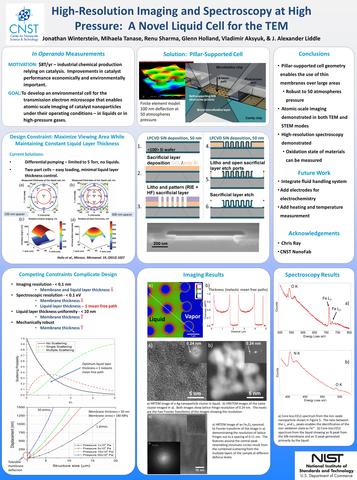Problem
Patent Description
The transmission electron microscope (TEM), with its ability to deliver atomic-scale spatial, and < 100 meV spectroscopic resolution, has enabled countless breakthroughs in materials science. From the early days of TEM development, researchers have sought to use the power of this technique to study dynamic processes occurring in wet or gaseous environments with mixed success, limited by available technology (Abrams & McBain, 1944; Baker & Harris, 1972; Marton, 1935; Swift & Brown, 1970). More recently, specialized environmental TEMs (ETEMs) (Sharma, 2001) have been developed to study reactions in gaseous environments with resolutions similar to unmodified TEMs. ETEMs have successfully contributed to understanding catalytic processes (Gai, 2002), growth of nanomaterials (Ross, 2010; Sharma, et al., 2007), phase transformations (Jeangros, et al., 2010; Sharma, et al., 2004; Wang, et al., 2009b), etc. Applying the unique capabilities of the TEM to elucidate catalyst performance under industrially relevant conditions has the potential to make a significant impact on the multi-billion-dollar catalyst market (Bartholomew & Farrauto, 2011; Bell, 2003), and on the $10 trillion chemical industry that relies on catalytic processes. ETEMs are, however, still limited in terms of the pressures and chemistries that can be accessed. In particular, the study of materials and processes in liquid environments is challenging and requires the use of special cells to encapsulate the liquid and protect the microscope. While there are a number of liquid cell approaches available, creating a thin, uniform liquid layer in a device that permits high spatial and spectroscopic resolution has proven to be difficult.
Here we demonstrate a method and apparatus for electron microscopy characterization and quantitative electron spectroscopy in fluids (we note that the same concepts can be applied to cell design and fabrication for in situ/operando measurements using, e.g. x-rays and neutrons). The fluid in the viewing area is constrained by thin membranes that are connected periodically by connectors fabricated in a monolithic fashion. The membrane thickness, distance between the membranes, and connector layout and spacing may all be adjusted in the fabrication process to suit a particular application.

Invention
A fluid sampler includes: a sample cell that includes: a substrate comprising: a first port; a viewing reservoir in fluid communication with the first port and the second port and that receives the fluid from the first port and communicates the fluid to the second port, the viewing reservoir including: a first view membrane; a second view membrane; and a pillar interposed between the first view membrane and second view membrane, the pillar separating the first view membrane from the second view membrane at a substantially constant separation distance such that a volume of the viewing reservoir is substantially constant and invariable with respect to a temperature and invariable with respect to a pressure to which the sample cell is subjected.
Features
In current practice, the lack of control over the device geometry introduces a considerable amount of variability which complicates the characterization of the sample. Our design resolves this problem by enabling the precise control over fluid flow, allowing for the possibility of controlled mixing, which does not so far exist. Additionally, our fabrication process and device design ultimately lead to a simpler, more robust system for these types of measurement.

